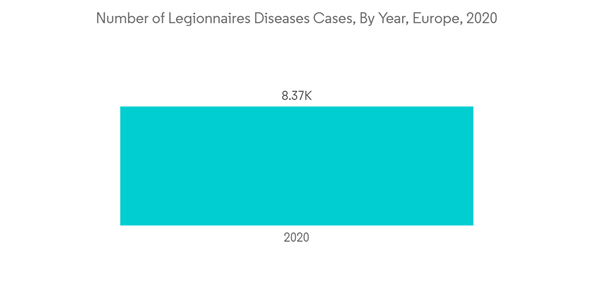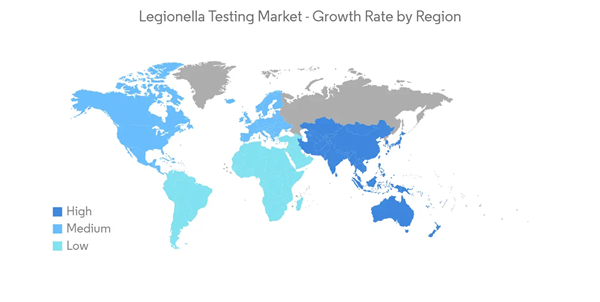The Global Legionella Testing Market size is estimated at USD 349.01 million in 2024, and is expected to reach USD 516.86 million by 2029, growing at a CAGR of 8.17% during the forecast period (2024-2029).
The emerging COVID-19 pandemic affecting the respiratory system, increased awareness about sanitization, and increased attention on the prevention of infectious diseases are all significantly influencing the market during COVID-19. According to the study published Pneumonia in January 2021, titled "Legionnaires' disease in the time of COVID-19" stated that because of similarities in initial clinical presentation, physicians may be tempted to screen community-acquired pneumonia cases for COVID-19 before identifying the need to test for Legionnaires' disease. Thus, an increase in pneumonia testing may positively influence the market during the COVID-10 pandemic.
The market is experiencing considerable growth, due to factors, like the rising incidence of pneumonia and legionella-related illnesses and increasing demand for rapid advanced diagnostic techniques and technological advancements in the field of bacterial testing. Legionella pneumonia is a relatively uncommon cause of community-acquired pneumonia. For instance, according to a study published in August 2021 titled 'Community-Acquired Pneumonia,' the estimated worldwide incidence of community-acquired pneumonia ranges from 1.5 to 14 cases per 1000 person each year, with geography, season, and population factors all playing a role. The annual incidence in the United States is 24.8 cases per 10,000 adults, with rates increasing with age. Because of the high occurrence, early proper preventive measures are required, which is predicted to fuel the growth of the legionella testing market.
As per the report published in May 2022 by European Centers for Disease Prevention and Control, legionnaires' disease is still a rare and occasional respiratory infection, with an overall reported rate of 1.9 cases per 100,000 people in Europe in 2020. France, Germany, Italy, and Spain accounted for 72% of all registered cases. Legionnaires disease is not contagious, but the disease can be contracted by contaminated water droplets and mist. Thus, an increase in the incidence of legionnaire disease is expected to propel the growth of the market.
Thus, all aforementioned factors are expected to boost market growth over the forecast period. However, issues in sensitivity of diagnostic tests may restrain the market growth over the forecast period.
Moreover, according to the study published in the International Journal of Environmental Research and Public Health in February 2022, titled "Global Perspective of Legionella Infection in Community-Acquired Pneumonia: A Systematic Review and Meta-Analysis of Observational Studies" the average incidence of community-acquired pneumonia (CAP) was 46.7 per 100,000 people. Legionella was found to be the causal agent of CAP in 4.6% of cases. As a result, the average Legionella incidence rate in 2020 was 2.8 per 100,000 population. Thus, the growing incidence of pneumonia and legionnaires-associated diseases is expected to boost segment growth.
However, over the forecast period, this test category is expected to grow significantly, because it provides differential advantages, like detection of entire serogroups associated with legionella and rapid testing. Its widespread use in the current market is limited due to the high cost of PCR techniques.
Additionally, various strategies adopted by the key market players are expected to fuel the market growth. For instance, in December 2021, Pace Analytical Services, a division of Pace Science and Technology Company and the preferred provider of in-lab, mobile, and emergency onsite specialty-contaminant and regulatory testing and analysis services, reported the acquisition of Special Pathogens Laboratory, a market leader in Legionella testing, detection, remediation, and prevention. Thus, owing to the above factors the market is expected to show growth over the forecast period in North America.
This product will be delivered within 2 business days.
The emerging COVID-19 pandemic affecting the respiratory system, increased awareness about sanitization, and increased attention on the prevention of infectious diseases are all significantly influencing the market during COVID-19. According to the study published Pneumonia in January 2021, titled "Legionnaires' disease in the time of COVID-19" stated that because of similarities in initial clinical presentation, physicians may be tempted to screen community-acquired pneumonia cases for COVID-19 before identifying the need to test for Legionnaires' disease. Thus, an increase in pneumonia testing may positively influence the market during the COVID-10 pandemic.
The market is experiencing considerable growth, due to factors, like the rising incidence of pneumonia and legionella-related illnesses and increasing demand for rapid advanced diagnostic techniques and technological advancements in the field of bacterial testing. Legionella pneumonia is a relatively uncommon cause of community-acquired pneumonia. For instance, according to a study published in August 2021 titled 'Community-Acquired Pneumonia,' the estimated worldwide incidence of community-acquired pneumonia ranges from 1.5 to 14 cases per 1000 person each year, with geography, season, and population factors all playing a role. The annual incidence in the United States is 24.8 cases per 10,000 adults, with rates increasing with age. Because of the high occurrence, early proper preventive measures are required, which is predicted to fuel the growth of the legionella testing market.
As per the report published in May 2022 by European Centers for Disease Prevention and Control, legionnaires' disease is still a rare and occasional respiratory infection, with an overall reported rate of 1.9 cases per 100,000 people in Europe in 2020. France, Germany, Italy, and Spain accounted for 72% of all registered cases. Legionnaires disease is not contagious, but the disease can be contracted by contaminated water droplets and mist. Thus, an increase in the incidence of legionnaire disease is expected to propel the growth of the market.
Thus, all aforementioned factors are expected to boost market growth over the forecast period. However, issues in sensitivity of diagnostic tests may restrain the market growth over the forecast period.
Legionella Testing Market Trends
Urinary Antigen Test (UAT) Segment is Expected to Hold a Major Market Share in the Legionella Testing Market
Urinary Antigen Test (UAT) is a diagnostic tool, which provides rapid outcomes, with usually same-day results. Additionally, UAT is not resource-specific and technically intensive like culture-based tests. Since UAT does not require respiratory fluid samples, issues of sensitivity are also overcome. according to the study published in the MDPI Journal in March 2021, titled "Evaluation of Four Lateral Flow Assays for the Detection of Legionella Urinary Antigen" stated that Legionella UATs had an overall sensitivity and specificity of 53.9-61.5% and 90.0-94.9%, respectively. However, Legionella UATs for L. pneumophila serogroup detection exhibited sensitivities and specificities ranging from 55.5-96% and 95.6-100%, respectively. Thus, the good sensitivity and specificity of UAT testing in the diagnosis of Pneumonia and legionnaires disease is expected to boost the segment growth.Moreover, according to the study published in the International Journal of Environmental Research and Public Health in February 2022, titled "Global Perspective of Legionella Infection in Community-Acquired Pneumonia: A Systematic Review and Meta-Analysis of Observational Studies" the average incidence of community-acquired pneumonia (CAP) was 46.7 per 100,000 people. Legionella was found to be the causal agent of CAP in 4.6% of cases. As a result, the average Legionella incidence rate in 2020 was 2.8 per 100,000 population. Thus, the growing incidence of pneumonia and legionnaires-associated diseases is expected to boost segment growth.
However, over the forecast period, this test category is expected to grow significantly, because it provides differential advantages, like detection of entire serogroups associated with legionella and rapid testing. Its widespread use in the current market is limited due to the high cost of PCR techniques.
North America is Expected to Hold a Significant Share in the Market and Expected to do Same During the Forecast Period
North America has dominated the market studied, due to the increasing cases of patients suffering from legionella infections and the presence of key players in this region. Additionally, to manage the prevalence of legionnaires diseases, the Government of the United States is increasing awareness among the general public with the environmental legionella isolation techniques Evaluation (ELITE) program, which may further augment the growth of the market. According to the National Collaborating Center for Environmental Health in June 2022, the documented prevalence of legionellosis in Canada is growing, with over 600 cases reported in 2019. The majority of outbreak-related deaths are linked to Legionella exposure from infected contaminated cooling towers, which can expose numerous people over a wide area.Additionally, various strategies adopted by the key market players are expected to fuel the market growth. For instance, in December 2021, Pace Analytical Services, a division of Pace Science and Technology Company and the preferred provider of in-lab, mobile, and emergency onsite specialty-contaminant and regulatory testing and analysis services, reported the acquisition of Special Pathogens Laboratory, a market leader in Legionella testing, detection, remediation, and prevention. Thus, owing to the above factors the market is expected to show growth over the forecast period in North America.
Legionella Testing Industry Overview
The legionella testing market is fragmented and competitive and consists of several major players. The companies are implementing certain strategic initiatives, such as a merger, new product launches, acquisitions, and partnerships, that help them in strengthening their market position. In terms of market share, a few of the major players are currently dominating the market. Some of the companies which are currently dominating the market are Albagaia Ltd, Aquacert Ltd, Becton, Dickinson and Company, BioMerieux SA, Merck Millipore (Merck KGaA), Pacific Water Technology, Pall Corporation (Danaher Corporation), Phigenics LLC, Qiagen NV, and Thermo Fisher Scientific Inc.Additional Benefits:
- The market estimate (ME) sheet in Excel format
- 3 months of analyst support
This product will be delivered within 2 business days.
Table of Contents
1 INTRODUCTION
4 MARKET DYNAMICS
5 MARKET SEGMENTATION (Market Size by Value - USD million)
6 COMPETITIVE LANDSCAPE
Companies Mentioned (Partial List)
A selection of companies mentioned in this report includes, but is not limited to:
- Albagaia Ltd.
- Aquacert Ltd.
- Becton, Dickinson and Company
- BioMerieux SA
- Merck KgaA
- Evoqua Water Technologies (Pacific Water Technology)
- Danaher Corporation (Pall Corporation)
- Phigenics LLC
- Qiagen NV
- Thermo Fisher Scientific Inc.
Methodology

LOADING...










